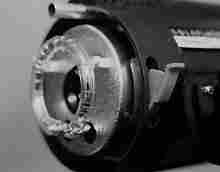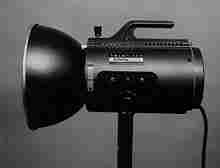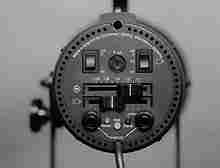
The name of Courtenay has appeared on electronic flash equipment for more than half a century, from portable battery-powered units, via the Nova studio generator packs, to modern monoblocs. The new Solaflash "X" models, rated at 150J, 300J, 600J and 1200J are the latest in this distinguished line. Whilst not being the cheapest units around, the new Courtenays do offer good value for money, with the more powerful units providing the greatest number of joules per pound (see table).
For many buyers, however, value for money is tempered by actual cost and realistic lighting requirements. A factor to be kept in mind here is the minimum power level that can be set, which is often at least as important as the maximum power output. Many older lights had just full, half and quarter power settings, while most (but not all) modern versions extend the range to eighth, sixteenth and even thirty-second powers. Opinions differ on what constitutes a useful power range and what is simply gimmick or wasted money: my own thoughts are that if you buy a high power unit and end up using it on lower power settings, then you have probably spent more than was really necessary. The fact that many excellent pictures have been shot with lights that are - by today's standards - rather inflexible, disproves the theory that power is nothing without control. That said, control is something that buyers of monoblocs expect to be offered today, and Courtenay does a fine job of providing it.

The units tested here were two 300X models, supplied in one large box that is described on the outside as a "complete 600 joule studio electronic flash lighting outfit." As well as the monoblocs, the box contained reflectors, stands, umbrellas, carrying cases, a sync lead, a flash meter and a 152-page book by former Photon contributor John Tinsley. This is by far the best information source included with any lighting kit seen so far. Total price for the Solaflash 300X/300X kit is £1,000 including VAT (US $1,500 inc taxes), of which, 70 per cent represents the value of the lights alone.
The most obvious difference between Courtenay's monoblocs and other designs is the hard-wired power lead. The logic behind this is very simple: each unit needs its own mains cable, and having these permanently attached ensures that they don't get lost or left behind when working on location. There may be a draw-back when mounting lights onto boom arms, when it can be useful not to have dangling cables, but this is not an insurmountable problem - unlike a missing power cable.
The mains plug is a moulded type with a pop-out fuse holder. Despite the technical data listing a 5A fuse, the review units were both fitted with 10A types. It appears that Courtenay has now standardised on this rating for all monoblocs, with individual models having their own appropriate on-board fuses. Interestingly, one of the two units supplied blew its on-board fuse during testing. Courtenay's explanation (and it is a reasonable one) is that the condensers may possibly not have been fully conditioned, but would become so during further use. In view of this initial hiccup, I will report back on whether or not the unit settles down at a future date. For the record, the second monobloc behaved impeccably throughout all tests.

Another significant difference is the reflector mounting system, which in Courtenay's case employs two hinged blades that are pushed in to lock accessories when fitted. The method is the same as that used on earlier Solaflashes, but differs from the previous Sola/Nova fitting.

All the lighting controls are on the monobloc's rear panel. Flash and modelling lamp outputs can be varied continuously and independent of each other. A three position rocker switch selects modelling lamp off, intermittent (extinguishing during flash recycling), or constantly on. Further controls comprise a master off/on switch, small red test button, red/green ready indicator, infra-red sensitive slave sensor and two sync sockets. In true Courtenay style, the rear panel is clear and uncluttered - more so than competitors' designs because Courtenay has located the carrying/adjustment handle elsewhere.
The black and red livery is discrete but, in my opinion, let-down by rather gaudy reflector-locking arms and the top-mounted handle, neither of which does anything for overall aesthetics. Obviously, the latter has to go somewhere - and putting it on the top of the housing does clear the rear panel - but the design doesn't look quite right as it is. This said, I am at a loss to come up with a better idea and readily recognise the advantages of an unobstructed control panel.
At low modelling lamp brightness there is a faint but definite hum. This originates from the torroidal choke that suppresses interference generated by the dimmer circuit. Although such matters were once of little concern, legislation is becoming increasingly stiff so it is good to see that Courtenay is taking the issue seriously. Equally encouraging is the fact that the lamp used in the "X" lights is a standard 150W P3/4 ES enlarger type. An alternative 75W version is also offered, allowing proportional modelling brightness with two monoblocs when one of them has twice the power of the other.
At 1/2,300, the 300X's t(0.5) full power flash duration is faster than most of its competitors. Two of the few exceptions come from Elinchrom: the mainstream EL250 has a duration of 1/2,500 (but at a lower maximum power) while the specialised EL250R betters an amazing 1/6,000 (but has a significantly higher price tag - £545).
Firing a sequence of full power flashes on the Courtenay 300X, waiting for the green ready lamp to light between each pop, resulted in an average recycling time of about 1.7s (compared to 1.5s given in the literature). Dropping to minimum (1/16 power) gave 0.8s against a claimed 0.6s figure. However, it is very difficult to be certain about these times because the Courtenay monoblocs - like Broncolor's - can be fired (using the flash test button) before full power is reached.
Interestingly, Broncolor has responded to the criticism raised over this point saying that when the perfect shot presents itself, it must surely be better to get a slightly under-exposed shot than none at all. This is a good argument, and one that should definitely be kept in mind when selecting equipment. On the other hand, what is the point of the perfect pose without the perfect exposure? Like so many things, it is a matter of paying your money and making your choice.
In Courtenay's case, explanations are unnecessary because premature firing is possible ONLY via the test button. When a sync socket or slave sensor provides the triggering signal, the monobloc will not fire unless fully recharged. Testing confirmed that output was totally consistent (within measurable limits) under these conditions. The same testing also revealed - surprisingly - that the 300X has a maximum output that is one full f-stop greater than an Elinchrom EL250 when both are fitted with their standard reflectors. To remove any reflector effects, another comparison was done bouncing the light off a large reflector panel. This time, the Courtenay was one and a half f-stops brighter!
One rather disconcerting discovery, however, was of flash triggering when the Courtenay monoblocs were switched back on after resting for a short while. A 300X that had been running at full power, then switched off and left to stand for twenty minutes or so, would fire an unexpected pop when re-activated. This is normal for the Courtenay lights, but comes as a surprise the first time it happens.
In absolute terms, these are genuine deficiencies, but it is hard to say whether or not variety really is the spice of life provided that the essentials are covered.
Physically, the 300X monoblocs are compact, being bettered only by some Elinchrom/Prolinca units. It is interesting to compare the stands supplied with those from Elinca. Although the stands have similar footprints in their most stable positions, and both extend to virtually the same maximum height (about 8ft), the two designs are fundamentally different.
Courtenay's stands are three section types whereas Elinchrom's are four. As a result, the Elinchrom stands pack down smaller and can be set 25 per cent lower. The Courtenay stands, with their larger diameter tubes, feel more solid. They are also more secure, requiring about 30% more sideways force to topple over by lifting one leg and withstanding about 50% more force before toppling by lifting two legs. This comparison between size and stability is more often applied to camera tripods, but it is important to remember that the same principles hold for lighting stands too. (Editor's note - Elinca offer many different stands including standard ones identical in size and stability to Courtenay... as indeed do most makers, given the ubiquitous rebranding of Manfrotto products).
Overall, the new Courtenay monoblocs are a definite improvement over the previous Solaflash models and do show signs of careful thought in their electronics. For example, even when several monoblocs are linked by cables, the test buttons still act on individual units. This means that a single light can be tested for exposure or general operation without needing to pull-out all the plugs. In common with other continuously variable flash output types, excess power must be dumped manually when reducing output, which is a shame. The hard-wired power lead is a great idea in my opinion - but not everybody I have spoken to agrees. The inclusion of a slow-start circuit in the modelling lamp's power supply is more user friendly (and lamp friendly) than the abrupt off/on action of some lights, but is only a minor consideration when making purchasing decisions.
What is far more important is the gathering into one box of all the necessary items needed to set up a home studio. Courtenay is clearly courting newcomers to monoblocs and ought to do well with the assembled kit, which certainly represents good value for money. Add in John Tinsley's book to provide introductory guidance, and the package ought to keep many a young photographer happy for a good while.
* Range of Accessories:
Fair (rather basic)
* Capital and Running Costs:
Very Good
* Performance:
Very Good
* Overall Rating:
As individual monoblocs, Courtenay's "X" lights are vastly superior to
the previous range of Solaflashes. Taken as a complete set, the Solaflash
300X/300X kit provides a particularly good introduction to studio flash
lighting.
NOTE: The previously titled "Lighting Quality" assessment is now renamed "Performance" to clarify exactly what it is that is being quantified. The grading given reflects flash output consistency, matching between modelling and flash lighting, and the amount of user control over both. It applies purely to the monoblocs themselves, and takes no account of the effect of any lighting accessories.